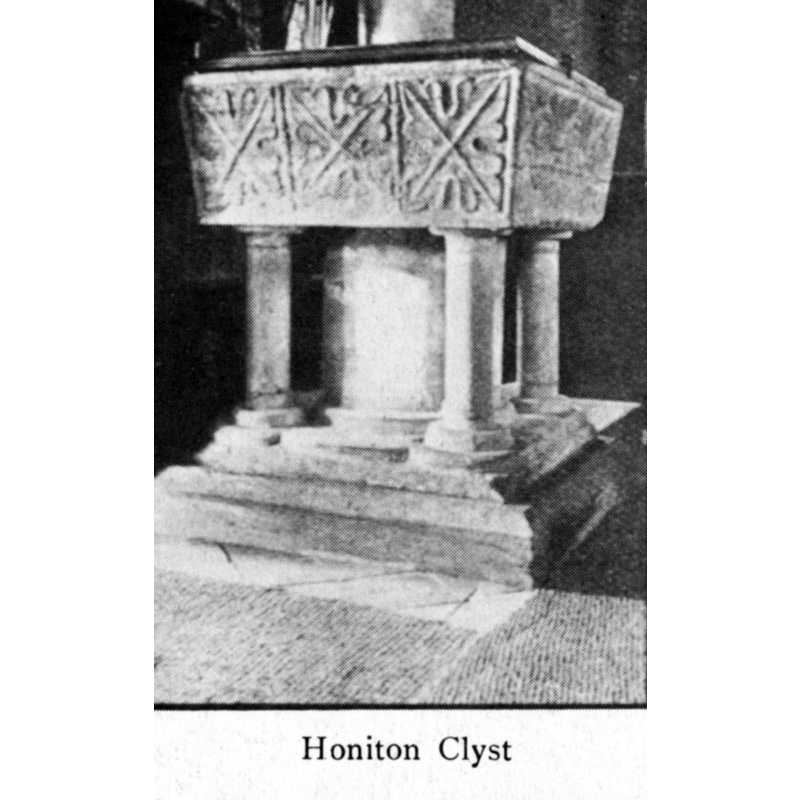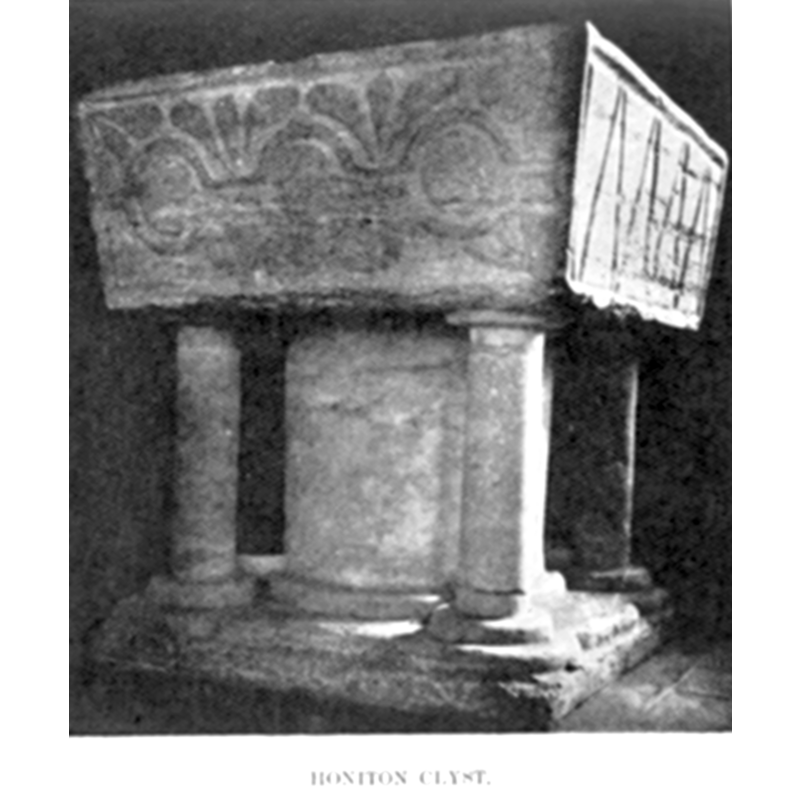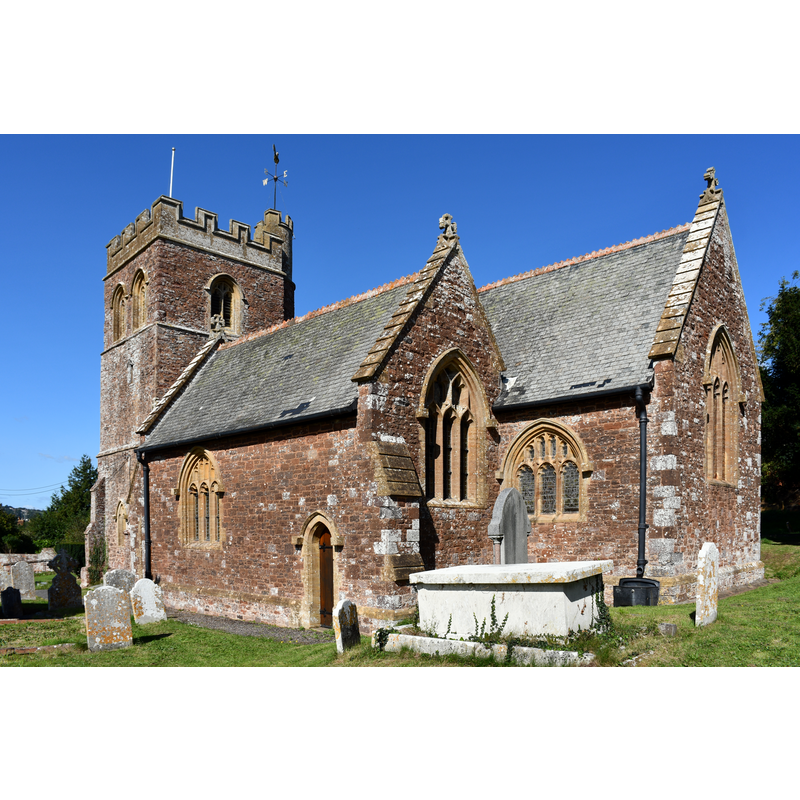Clyst Honiton / Honiton Clyst / Clist Noniton / Honetone

Image copyright © [in the public domain]
PD
Results: 8 records
B01: design element - motifs - foliage
B02: design element - motifs - medallion - 3
B03: design element - motifs - zigzag
B04: design element - motifs - foliage
B05: design element - motifs - groove
view of church exterior - southeast view
view of font
INFORMATION
FontID: 05334CLY
Object Type: Baptismal Font1
Church/Chapel: Parish Church of St. Michael and All Angels
Church Patron Saints: St. Michael & All Angels
Church Location: Clyst Honiton, Exeter EX5 2LY, United Kingdom -- Tel.: +44 1392 468928
Country Name: England
Location: Devon, South West
Directions to Site: Located off (N) the A30 [aka Honiton Rd], 6 km ENE of Exeter
Ecclesiastic Region: Diocese of Exter
Font Location in Church: Inside the church
Date: ca. 1150?
Century and Period: 12th - 13th century [re-carved], Norman? / Transitional? [altered]
Cognate Fonts: Clarke (1922) describes it as one nine Devon 'table fonts': Bondleigh, Hennock, Holbeton, Honiton Clyst, Mariansleigh, North Lew, Petrockstowe, Roseash and Washfield [see also FontNotes]
Font Notes:
Click to view
No entry found for Clyst Honiton in the Domesday survey. Listed in Lysons (1806-1822) as one of a group of square baptismal fonts in the county that are "for the most part supported by four pillars and a large pedestal in the centre". Lewis' Dictionary of 1848 notes: "The church [...] contains what is supposed by antiquaries to be the original Saxon font". Hutchinson (2010), who visited the church in 1885, commented in his diary that the "somewhat curious structure" appeared to be made of Beer stone and Purbeck marble. Listed in Cox & Harvey (1907) as a baptismal font of the Norman period. Described and illustrated in Bond (1908) as a square mounted font of the 13th century; the basin is wider at the top than at the bottom, therefore trapezoidal, each side ornamented with three large leaves. The base consists of a broad central column with four slender colonnettes at the corners; the lower base and the plinth are square as well, all plain. The plain flat wooden cover appears modern. Clarke (1922) describes it as one nine Devon 'table fonts' (Bondleigh, Hennock, Holbeton, Honiton Clyst, Mariansleigh, North Lew, Petrockstowe, Roseash and Washfield) that belong to the thirteenth century, "though the ornament on the bowls is of that date their heavy construction suggests a Norman origin, so that they have often been wrongly attributed to the twelfth century". In her detailed description of this font Clarke (ibid.) identifies the main material as limestone but suggests 'a scoriated stone, such as Thorverton trap" for the outer colonnettes of the base. The entry for Tortington (West Sussex) in the CRSBI [www.crsbi.ac.uk/ed/sx/torti/Index.htm] gathers information for several sources that favour the existence of a workshop in Dorset ca. 1150 responsible for the manufacture of the fonts at Torrington, Bishop's Teignton, Honiton, South Molton, Dun[kes?]well, Luppitt and Blackhawton. Described in Pevsner (1952): "Font. Square Norman bowl of table-top type, one side with the usual shallow blank arcades, another with a plain fluted zigzag motif, the other two reworked in the C16 or C17." The entry for this church in Historic England [Listing NGR: SX9894293525] notes: "Parish church. C12 font, the basic fabric appears to be C15 or earlier and some C15 detail remains in north aisle but the whole church was thoroughly restored with a new south chapel and south porch in 1875 [...] C12 late Norman granite font. The square bowl is supported on a central column and 4 smaller shafts on the corners with moulded caps and bases. It sits on a Victorian plinth. The edges of the bowl cant forward slightly towards the top and the ornament varies each side including simple chevrons, scallops and stylised foliage; some may be secondary. It has a C19 lid [...] Although much of the basic fabric appears to be medieval the church is essentially the result of a thorough and consistent restoration of 1875, an attractive and coherent scheme. Only the font, the aisle arcade and one of the north aisle windows are pre-1875 detail." Noted in Leach (1975) as a font made of Purbeck marble without further deatisl [source given: Pevsner's South Devon, 1952]
COORDINATES
Church Latitude & Longitude Decimal: 50.73252, -3.4334
Church Latitude & Longitude DMS: 50° 43' 57.1" N, 3° 26' 0.0" W
UTM: 30U 469414 5620170
MEDIUM AND MEASUREMENTS
Material: stone, granite / limestone [outer base colonnettes probably made of Thorverton trap] / limestone (Purbeck marble)
Font Shape: square (mounted)
Basin Interior Shape: round
Basin Exterior Shape: square
Drainage Notes: lead lining
Rim Thickness: 8.5 - 9 cm [calculated]
Diameter (inside rim): 58.75 cm*
Diameter (includes rim): 76.25 cm*
Basin Depth: 26.25 cm*
Basin Total Height: 31.25 cm*
Height of Central Column: 37.5 cm*
Font Height (less Plinth): 81.25 cm*
Font Height (with Plinth): 89.25 cm* [81.25 + 8]
Notes on Measurements: * [measurements given in inches in Clarke (1922: 223)]
LID INFORMATION
Date: modern / 19th century
Material: wood
Apparatus: no
Notes: [cf. FontNotes]
REFERENCES
Bond, Francis, Fonts and Font Covers, London: Waterstone, 1985 c1908
Clarke, Kate M., "The baptismal fonts of Devon -- Part IX", 54, Report and Transactions of the Devonshire Association for the Advancement of Science, Literature and Art, 1922, pp. 216-223; p. 218-219, 223 and fig. 2 (opp. p. [216])
Cox, John Charles, English Church Furniture, New York: E.P. Dutton & Co., 1907
Hutchinson, Peter Orlando, Diary of a Devon antiquarian: the illustrated journals and sketchbooks of Peter Olrlando Hutchinson, 1871-1894, Wellington, Somerset: Halsgrove, 2010
Leach, Rosemary, A Investigation into the use of Purbeck Marble in Medieval England, Hartlepool: E.W. Harrisons & Sons, 1975
Lewis, Samuel, A Topographical Dictionary of England, Comprising the Several Counties, Cities, Boroughs, Corporate and Market Towns, Parishes, Chapelries, and Townships, and the Islands of Guernsy, Jersey, and Man, with Historical and Statistical Descriptions [...], London: S. Lewis, 1831
Lysons, Daniel, Magna Britannia, being a concise topographical account of the several counties of Great Britain, London: Printed for T. Cadell and W. Davies, 1806-1822
Pevsner, Nikolaus, South Devon, Harmondsworth: Penguin Books, 1952



